17 Customer Segmentation Analysis Methods Experts Actually Use in 2025

Customer segmentation analysis delivers real results – 80% of companies report better sales after implementing it. Our clients have experienced similar success when they moved from generic marketing to targeted approaches.
The power of this technique lies in its ability to divide your audience into distinct groups that receive customized content based on their specific needs. Research shows that 91% of consumers prefer shopping with brands that provide relevant recommendations. This explains why businesses of all sizes use different customer segmentation methods based on their data collection processes, tools, and audience size.
The impact goes well beyond marketing success. Companies that use segmentation data are 130% more likely to understand their customers’ motivations and 60% more likely to learn about their concerns and challenges. These techniques are a great way to get better user involvement, feature adoption, and product development.
Our research reveals the customer segmentation models that will deliver results in 2025. These 17 methods range from demographic breakdowns to sophisticated behavioral tracking, representing the most effective customer segment definitions used by market leaders today. Let’s look at each method to help you build a stronger business strategy.
- 17 Customer Segmentation Analysis Methods Experts Actually Use in 2025
- Demographic Segmentation
- Behavioral Segmentation
- Geographic Segmentation
- Psychographic Segmentation
- Technographic Segmentation
- Needs-Based Segmentation
- Value-Based Segmentation
- Firmographic Segmentation
- Customer Journey Segmentation
- Lifecycle Stage Segmentation
- RFM Segmentation
- Satisfaction Score Segmentation
- Channel-Based Segmentation
- Device Type Segmentation
- Source-Based Segmentation
- Coupon Usage Segmentation
- Interest-Based Segmentation
- Comparison Table
- Conclusion
- Key Takeaways
- FAQs
Demographic Segmentation
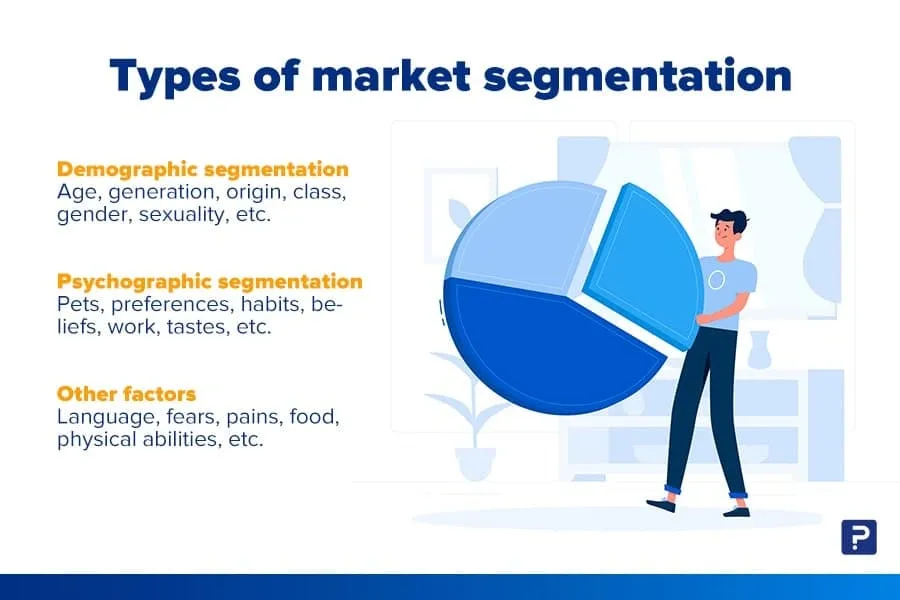
Image Source: QuestionPro
Demographic segmentation groups your audience based on observable characteristics like age, gender, income, and education level. This method helps companies arrange their marketing efforts according to specific customer profiles instead of using a one-size-fits-all approach.
What is Demographic Segmentation
Demographic segmentation groups consumers who share measurable traits. These traits include:
- Age and generation
- Gender identity
- Income level and occupation
- Education background
- Family size and marital status
- Ethnicity and nationality
- Religion and cultural background
Market segmentation starts with demographics because the data is easy to collect and analyze. Companies can create targeted marketing campaigns with clear, objective parameters.
Why Demographic Segmentation works
Demographic segmentation succeeds because it creates relevant experiences. Studies show 91% of consumers choose to shop with brands that offer customized experiences. These insights help companies tailor their offerings effectively.
Demographic segmentation lets businesses:
- Create personalized marketing messages for specific groups
- Direct resources to segments with high potential
- Cut marketing costs by 50% while growing revenue by 10-15%
- Get $20 back for every $1 spent on personalization
Companies that use demographic segmentation report better customer satisfaction. Their customers stay loyal longer because the company understands their needs better.
How to apply Demographic Segmentation
A systematic approach to data collection and analysis makes demographic segmentation work:
- Gather demographic data through:
- First-party sources: Surveys, website forms, and customer interviews
- Second-party data: Industry reports and market research studies
- Third-party sources: Data vendors, public records, and census information
- Create customer personas that represent different demographic segments
- Customize marketing approaches for each segment based on their priorities and challenges
- Adjust pricing strategies to match target demographics’ purchasing power
- Monitor and refine your strategy based on performance metrics and market changes
Demographic segmentation helps companies build stronger connections with customers. This approach encourages better relationships and enhances customer experience.
Behavioral Segmentation
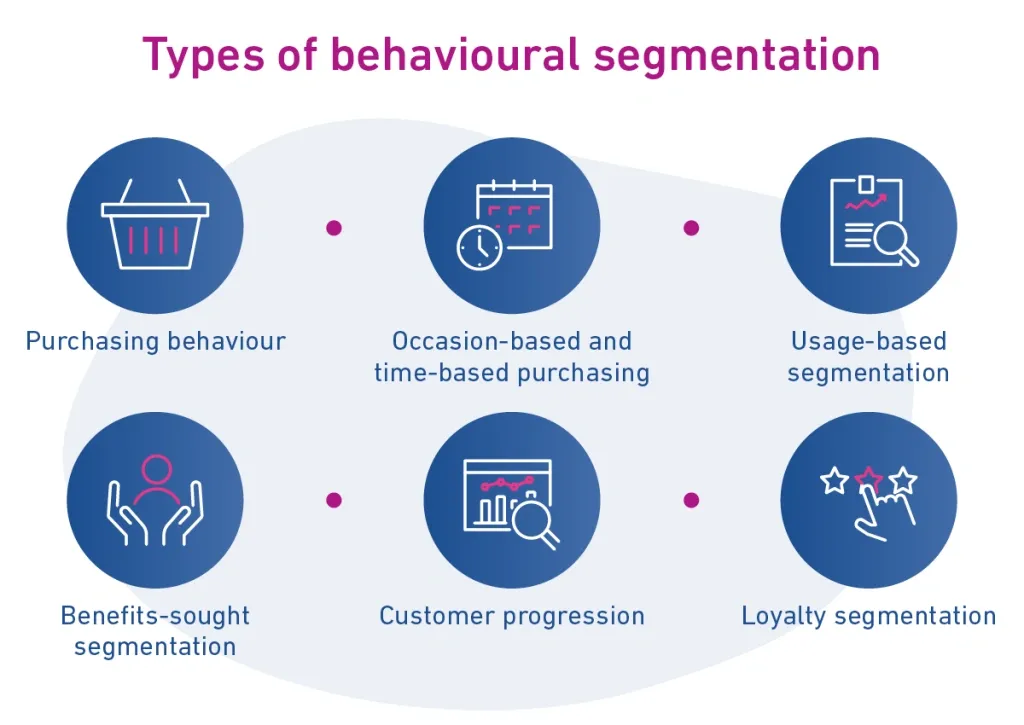
Image Source: Experian
Behavioral segmentation looks at what customers do instead of who they are. This powerful way to group customers focuses on their actions, habits, and how they interact with your brand.
What is Behavioral Segmentation
Behavioral segmentation groups customers based on how they interact with your products or services. These behaviors include:
- Purchasing patterns and frequency
- Product usage habits and engagement levels
- Brand interactions across touchpoints
- Decision-making processes
- Knowledge and awareness of your offerings
The core of behavioral segmentation lies in understanding how and when customers make decisions rather than just their demographic traits. This helps you spot patterns that show what drives customers and what they like.
Why Behavioral Segmentation works
Behavioral segmentation works because it can predict what people will do based on what they’ve done before. Research shows that 71% of U.S. consumers want brands to customize their experiences. About 76% get frustrated when businesses don’t meet these expectations.
Behavioral segmentation gives you several benefits:
- Improved targeting accuracy: Marketing messages based on specific behaviors can increase conversion rates up to 3x
- Better personalization: Segmented email campaigns get 14.31% higher open rates than non-segmented ones
- Economical solutions: You can focus resources on segments that are most likely to convert
- Increased brand loyalty: 80% of customers prefer doing business with brands that offer customized experiences
Companies that use behavioral data sell up to 85% more than their competitors.
How to apply Behavioral Segmentation
You need a systematic approach to make behavioral segmentation work:
- Collect the right behavioral data: Keep track of purchases, website visits, app usage, and how people respond to campaigns
- Choose appropriate tools: Set up customer data systems to collect events and analytics platforms to analyze groups
- Start with simple segments then move to more complex behavioral groups
- Activate in live: Launch automated campaigns based on specific behaviors and update segments as new data comes in
- Test and refine: Run A/B tests to make your segments and messages better
Behavioral segmentation lets you send the right messages exactly when customers need them, which improves engagement and sales a lot.
Geographic Segmentation
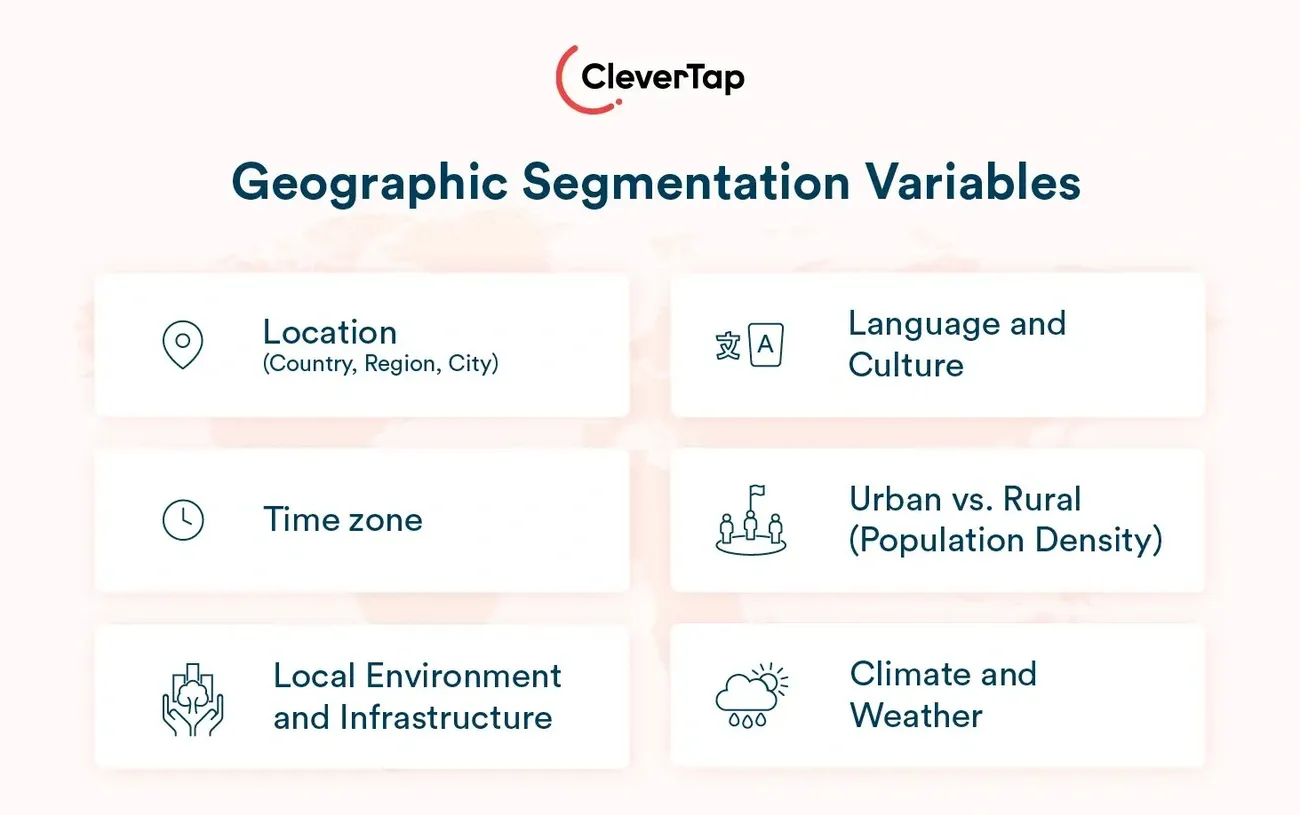
Image Source: CleverTap
Location is a vital part of customer segmentation analysis. Geographic segmentation splits your market based on physical location from countries and regions down to specific postal codes. This targeted marketing approach appeals to local audiences effectively.
What is Geographic Segmentation
Geographic segmentation groups customers based on where they live, work, or shop. The method relies on six main variables:
- Location (country, region, city, ZIP code)
- Climate and seasonal patterns
- Cultural priorities and sensitivities
- Language variations
- Population density (urban, suburban, rural)
- Time zones
People in different locations naturally have distinct needs, priorities, and shopping behaviors that shape their purchasing decisions.
Why Geographic Segmentation works
Geographic segmentation produces results that matter. The quickest way to implement it comes from location data needing fewer data points than other segmentation methods. Marketing materials can reflect local cultures, events, and references to build authentic connections with customers.
The method helps optimize marketing budget allocation by targeting areas that promise the highest returns. Companies that use geographic targeting see their social media content generate up to six times more engagement than generic national posts.
How to apply Geographic Segmentation
A successful geographic segmentation strategy requires:
- Collect location data through customer surveys, website analytics, and purchase records
- Determine segmentation scope based on your business needs, whether broad (country-level) or granular (neighborhood-level)
- Analyze regional characteristics including climate, cultural nuances, and local priorities
- Tailor your approach by customizing products, pricing, and marketing messages for each geographic segment
Your geographic targeting strategy needs regular monitoring of performance metrics as markets change and evolve.
Psychographic Segmentation
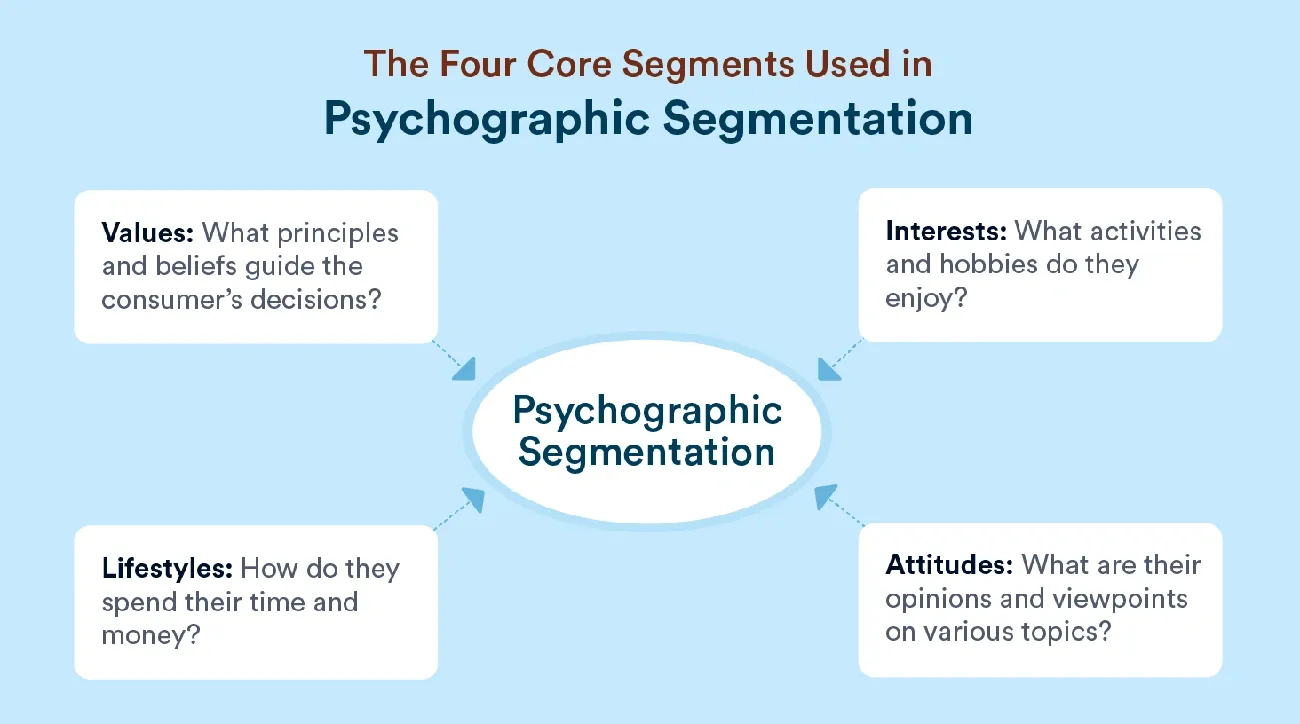
Image Source: CleverTap
The real magic of understanding customers lies beyond their basic traits. Psychographic segmentation looks deep into consumers’ minds and groups them by their psychological characteristics and what drives them. This approach reveals something that regular segmentation often misses – the real reasons behind customer choices.
What is Psychographic Segmentation
Psychographic segmentation groups audiences based on psychological criteria, including:
- Values and beliefs
- Lifestyle choices and daily habits
- Personality traits
- Interests, hobbies, and activities
- Social class and status
- Attitudes and opinions
Demographics tell us about age and income, but psychographics takes a closer look at the mechanisms that shape consumer behavior. This method helps us learn about what really influences buying decisions and gives us better insights than traditional market segmentation approaches.
Why Psychographic Segmentation works
Psychographic segmentation gets results. It helps businesses target specific audiences who share similar psychological traits. You can spot distinct groups of people who think alike and share the same motivations, rather than just broad demographic categories.
Psychographic data has longevity. Getting reliable information can be tricky, but the insights last longer than behavioral and demographic data. People’s attitudes, values, and needs are deeply embedded and change more slowly than other characteristics.
Companies that use psychographic segmentation see better customer loyalty because people naturally connect with brands that understand them. Marketing messages hit home when they speak to specific values and motivations.
How to apply Psychographic Segmentation
You need good data to make psychographic segmentation work. Here’s how to get it:
Start with surveys that ask open-ended questions about customer priorities, interests, and lifestyle choices. Tools like SurveyMonkey are economical solutions for this task.
Focus groups help you understand what motivates consumers as a group. Social media analysis shows valuable psychographic patterns – what content people like, which pages they follow, and their comments.
Create detailed buyer personas for each psychographic segment that show their values, interests, and lifestyle choices. These insights help shape your marketing messages, product development, and customer experiences.
Technographic Segmentation
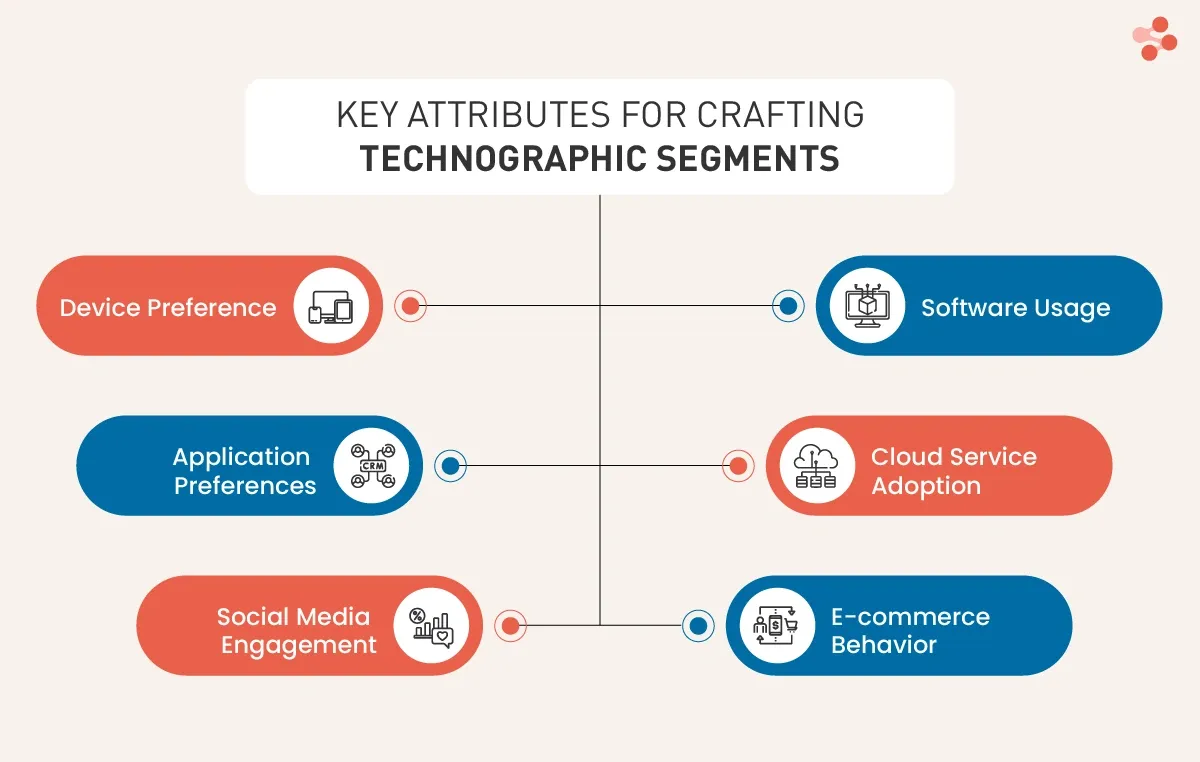
Image Source: Smarte
Technology stacks and digital priorities give us great insights into how consumers behave. Technographic segmentation splits customers into groups based on their technology usage, adoption patterns, and priorities. This helps marketers create targeted strategies for tech-savvy audiences.
What is Technographic Segmentation
Technographic segmentation groups customers by the technology they use or own. The approach looks at these key areas:
- Device ownership and usage (smartphones, tablets, laptops)
- Software usage (operating systems, productivity tools)
- Cloud services utilization (storage, collaboration tools)
- Digital media consumption patterns
- E-commerce activities and priorities
B2B technographic segmentation looks at the technology stacks companies employ, which includes software, tools, platforms, and infrastructure they’ve implemented. This shows us their technological maturity, priorities, and potential pain points.
Why Technographic Segmentation works
Technographic data reveals decision-making patterns that demographic or firmographic information can’t show. Companies can use this approach to:
- Find new target markets through technology usage patterns
- Track emerging technology trends within industries
- Create marketing messages that fit specific technology environments
- Learn about competitive landscapes and market opportunities
Technology enterprises, SaaS businesses, and professional service providers can use technographic segmentation to target audiences with precision. Keep in mind that technology usage matters more in some industries than others.
How to apply Technographic Segmentation
The quickest way to implement technographic segmentation includes:
- Web-based surveys to collect technology usage data
- Customer interviews and focus groups to understand adoption patterns
- Website scraping to gather publicly available technology information
- Third-party data providers who specialize in technographic insights
Many organizations group customers using Rogers’ technology adoption lifecycle: innovators, early adopters, early majority, late majority, and laggards. While this approach has benefits, technographic data changes faster, so you need regular updates to stay accurate.
Needs-Based Segmentation
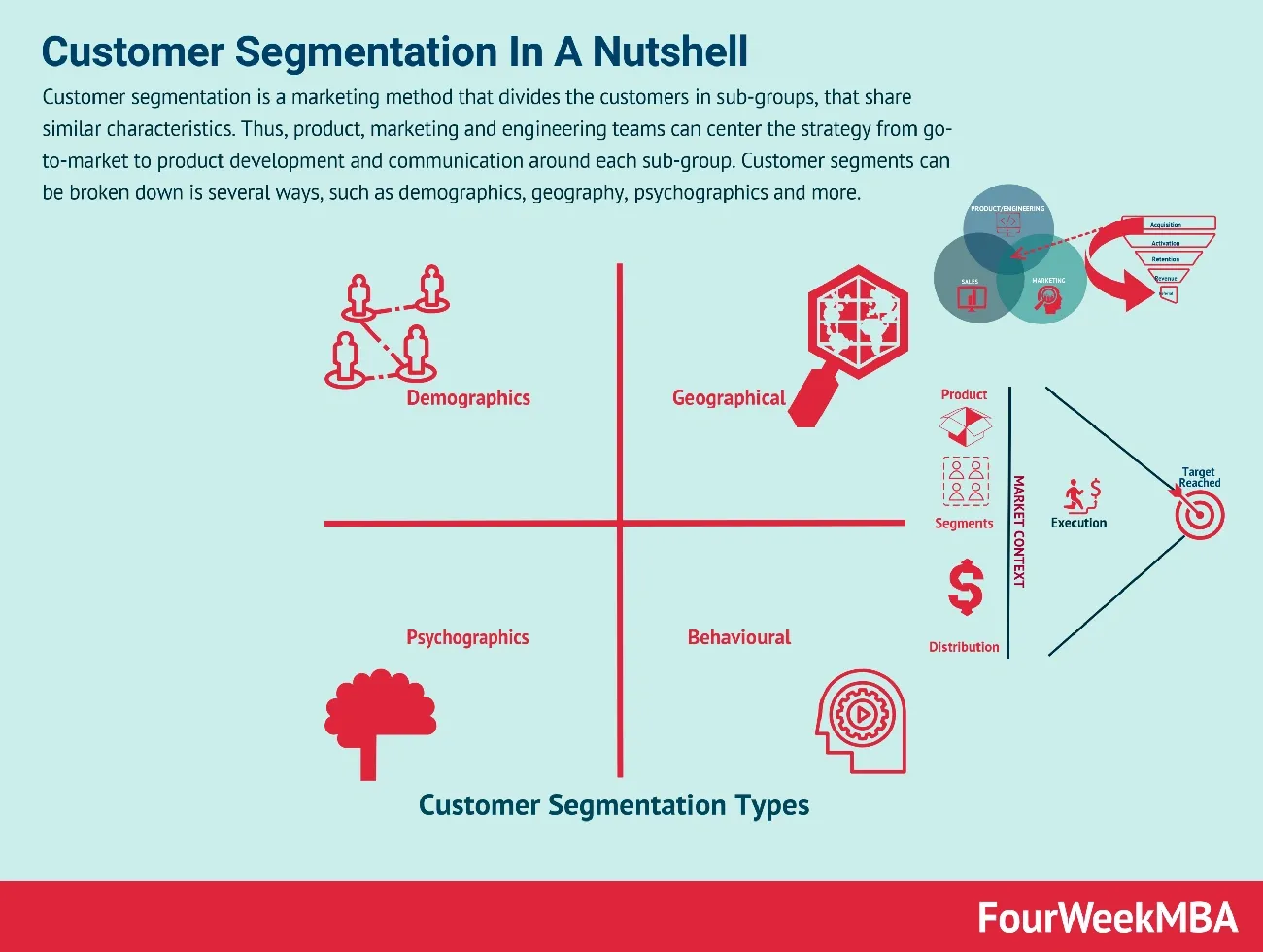
Image Source: FourWeekMBA
Customer motivations are the key to targeting markets effectively. Needs-based segmentation splits audiences into groups that share similar problems or seek similar benefits. This approach focuses on understanding why customers make their purchasing decisions.
What is Needs-Based Segmentation
Needs-based segmentation groups customers according to their specific needs and priorities instead of basic traits like age or location. We want to discover what drives consumer behavior and what matters most to different customer groups. The core question it answers is simple: what problems do your customers want to solve with your product?
Why Needs-Based Segmentation works
This method gets results because we focused on customer motivations. Traditional segmentation doesn’t capture the real reasons behind purchasing decisions, but needs-based insights help us learn about customer priorities.
Benefits include:
- Better personalization that improves participation
- Stronger customer loyalty by fixing real pain points
- Products that match what the market needs
- Smart resource use focused on valuable segments
- Standing out from competitors by meeting specific customer needs
How to apply Needs-Based Segmentation
Getting meaningful customer insights requires:
- Data collection through surveys, interviews, feedback forms, and support interactions
- Information analysis to spot common themes and pain points
- Segment creation based on shared needs using statistical methods like cluster analysis
- Message and offer testing with smaller audience groups
- Regular segment updates as customer needs change
Needs-based segmentation becomes more powerful when combined with other segmentation methods to identify and reach segments.
Value-Based Segmentation
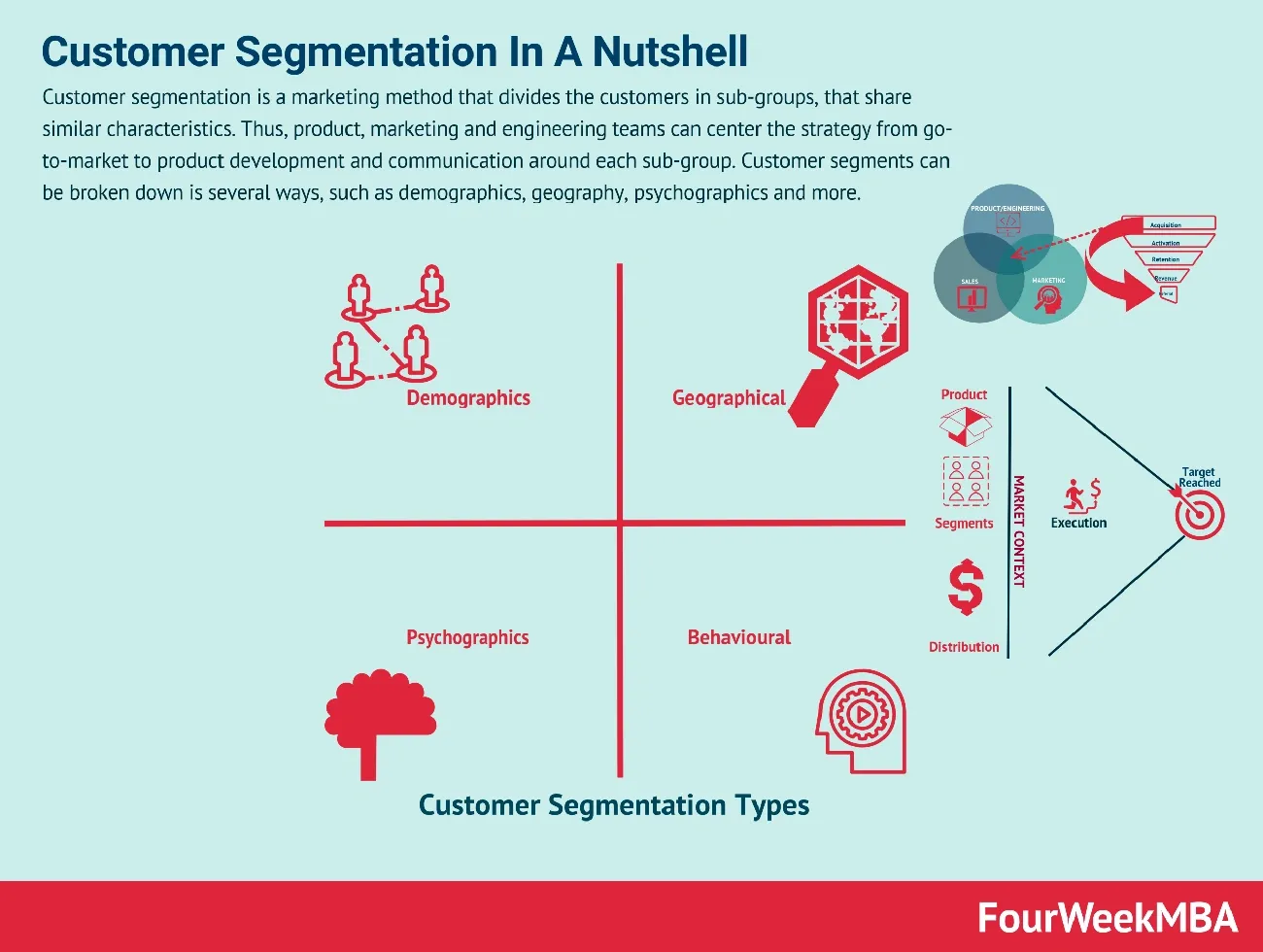
Image Source: FourWeekMBA
Value-based segmentation assesses customers by their economic contribution to your business. This method ranks audience groups based on their profitability and provides strategic direction for resource allocation and marketing efforts.
What is Value-Based Segmentation
Your company’s financial worth over time determines how value-based segmentation divides customers. The approach focuses on metrics that show direct and indirect value:
- Business Value – Measures direct value through transactional data, average purchase size, product usage, or customer lifetime value (CLV)
- Engagement Value – Shows indirect value through marketing interactions, content engagement, and consent permissions
- Cost to Service/Acquire – Shows actual cost and profitability of customer relationships
Most segmentation methods focus on customer identity or behavior. Value-based segmentation prioritizes their monetary effect on your bottom line.
Why Value-Based Segmentation works
Companies can identify customers with the highest return potential through value-based segmentation. The method answers key questions like “Who are our most valuable/loyal customers?” and “What is the value-gain by moving customers from one segment to another?”
Companies using this approach see several benefits:
- Higher customer lifetime value through targeted messaging
- Boosted customer satisfaction through personalization
- Better customer retention rates
- Smarter marketing spend allocation
Value-based segmentation helps companies become more data-driven and shows the potential ROI of investing in analytics capabilities.
How to apply Value-Based Segmentation
Value-based segmentation requires these strategic steps:
- Gather customer data – Collect transactional information, engagement metrics, and service costs
- Analyze customer value – Assess direct and indirect contributions using appropriate metrics
- Define value segments – Create groups based on varying levels of business value
- Develop personalized strategies – Create tailored approaches for each segment
- Implement and test – Use segment-specific messaging and assess effectiveness
The method works well with business models of all types including B2B, B2C, subscription-based, and online-only operations. Adding variables like CLV, activity probability, and demographic information enables precise targeting and optimal results.
Firmographic Segmentation
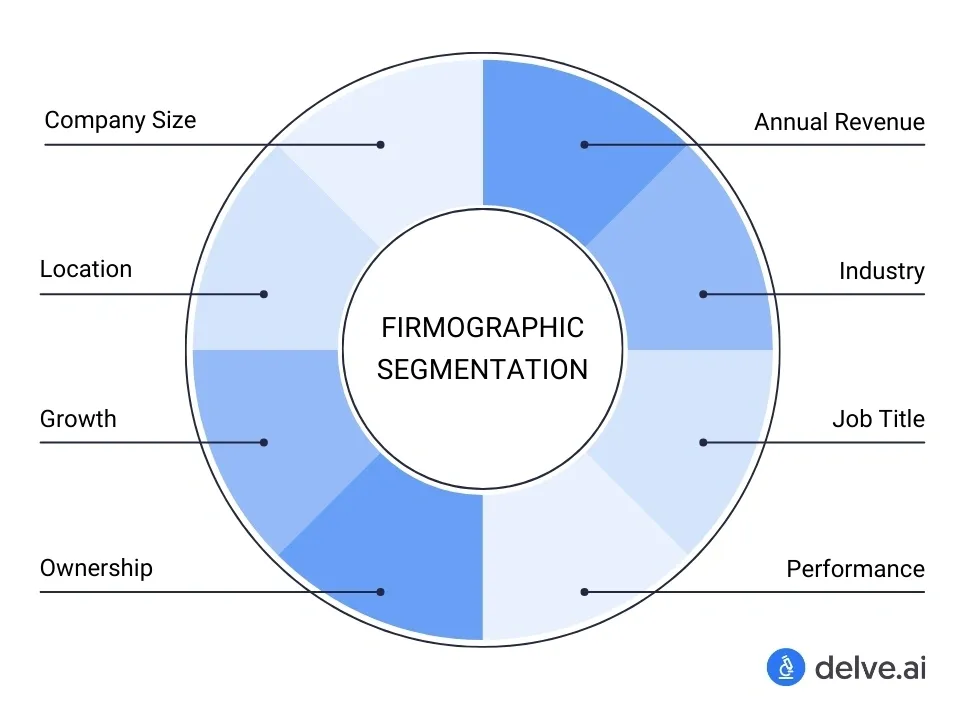
Image Source: Delve AI
B2B marketers need to understand organizational characteristics to analyze customer segmentation effectively. Firmographic segmentation offers a framework that targets businesses based on shared attributes instead of individual consumer traits.
What is Firmographic Segmentation
Firmographic segmentation classifies organizations based on shared business characteristics. This B2B approach groups potential customers by company-specific variables rather than individual traits. The main firmographic attributes include:
- Industry type/sector
- Company size (employee count)
- Annual revenue
- Geographic location
- Company structure/ownership
- Growth stage
- Decision-maker titles
Firmographics work like demographics for organizations and provide vital data points that help define your target market.
Why Firmographic Segmentation works
B2B marketers can tailor their strategies to specific organization types through firmographic segmentation. This approach offers several benefits:
The method optimizes targeting and provides economical solutions by directing resources to high-potential segments. Forrester’s research shows companies using sophisticated segmentation strategies achieve up to 20% higher revenue growth.
Firmographic data makes individual-specific experiences possible. Studies reveal personalization boosts marketing ROI by 5-8 times and increases sales by at least 10%.
The approach arranges sales and marketing teams better. Gartner reports show representatives who focus on pre-qualified firmographic segments can improve their output by up to 30%.
How to apply Firmographic Segmentation
B2B marketers can implement firmographic segmentation through these steps:
- Define clear objectives for your targeting efforts
- Gather accurate data from trustworthy sources, updating at least monthly
- Analyze patterns within collected information to identify high-value groups
- Create targeted segments based on shared characteristics
- Develop personalized campaigns for each segment
- Monitor performance and adjust strategies based on results
B2B marketers who understand firmographic segmentation can create precise targeting approaches that lead to better conversion rates.
Customer Journey Segmentation
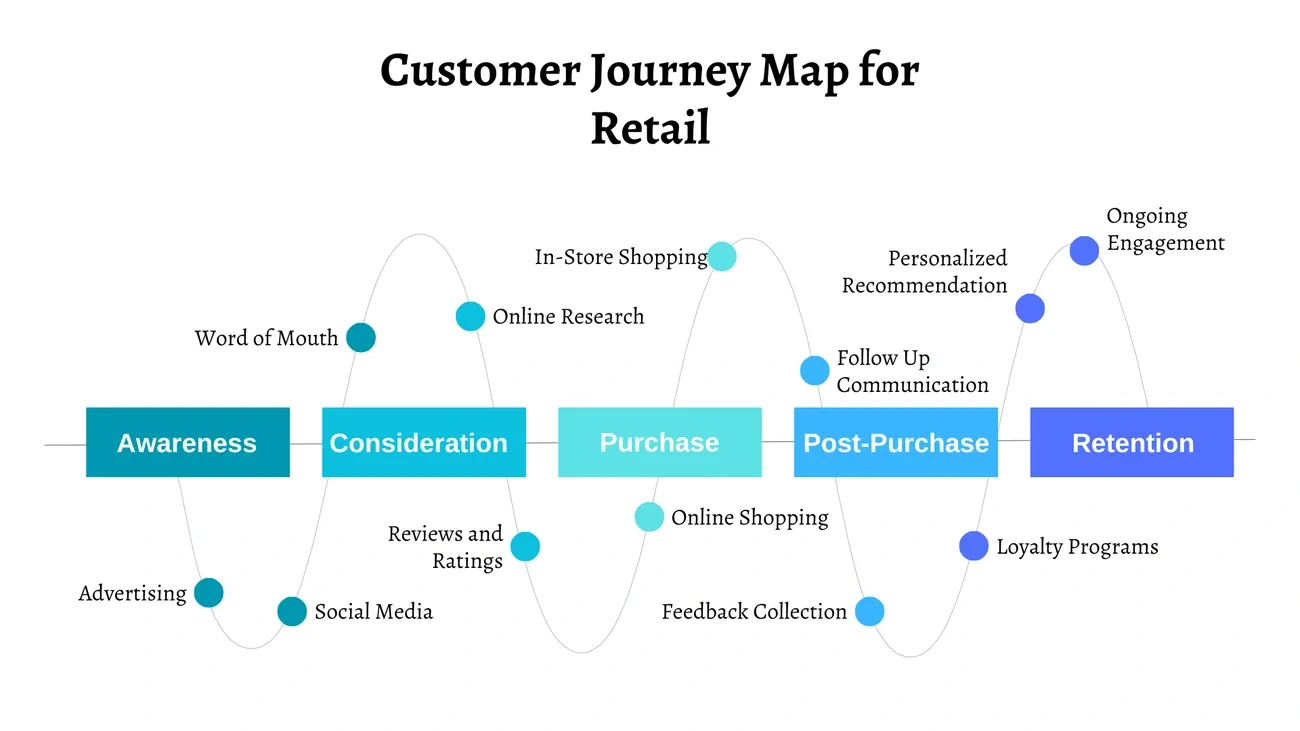
Image Source: Zonka Feedback
Your customers interact with your business differently at each stage of their purchase experience. This provides great insights into customer segmentation. You can categorize your audience based on their paths to purchase and how they engage with different touchpoints.
What is Customer Journey Segmentation
The way customers interact with your business varies from their original awareness to after-purchase support. Customer journey segmentation groups your customers based on these interactions. This approach looks at the sequence of touchpoints, time between interactions, and emotional responses at each stage. We used this method to identify different patterns in how customers move through your purchase funnel.
Why Customer Journey Segmentation works
Companies can create individual-specific experiences by understanding the unique paths each customer group takes. This method helps spot issues specific to each segment and makes targeted improvements to boost satisfaction. You can also learn about how customers change between segments as their needs evolve.
How to apply Customer Journey Segmentation
Start by gathering experience data through direct feedback from post-transaction surveys and indirect signals from online reviews. Map each segment’s customer experience and highlight key touchpoints and responses. Look for segment-specific issues and opportunities. Create content and support strategies that match each type of customer experience.
Lifecycle Stage Segmentation
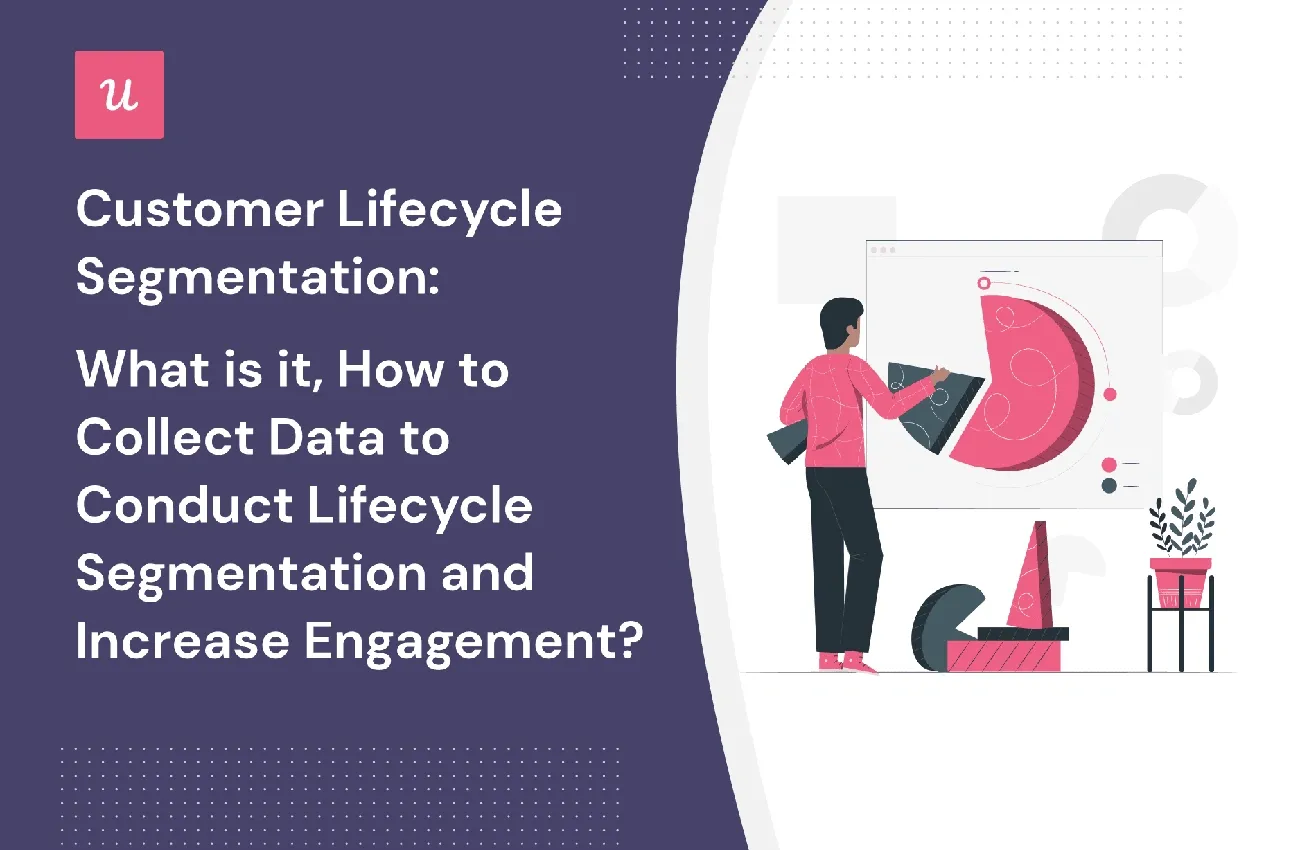
Image Source: Userpilot
Brands can learn a lot about their customers by understanding how relationships evolve over time. Lifecycle stage segmentation helps group customers based on their relationship with your company – from initial discovery to becoming loyal advocates.
What is Lifecycle Stage Segmentation
Lifecycle stage segmentation groups customers by their current relationship phase with your brand. The stages include subscriber, lead, marketing qualified lead, sales qualified lead, opportunity, customer, evangelist, and others. This approach reveals more than just demographics or behaviors. It shows how customers feel and act at specific points in their experience.
Why Lifecycle Stage Segmentation works
The results speak for themselves. Segmented email campaigns achieve 14.31% higher open rates and click-through rates up to 100.95% higher than regular campaigns. Companies reduce churn rates, boost customer satisfaction, and improve conversion rates effectively. Your messages focus more on helping rather than selling when you understand where customers are in their experience. This builds trust and creates long-term loyalty.
How to apply Lifecycle Stage Segmentation
You need to:
- Collect engagement data (email opens, clicks, website visits)
- Track behavioral signals (product views, cart abandonment)
- Use AI to predict future behaviors
- Create automated workflows that adjust based on stage transitions
Quick responses to customer behavior keep momentum going in their experience. This builds trust and increases the chances of conversion.
RFM Segmentation
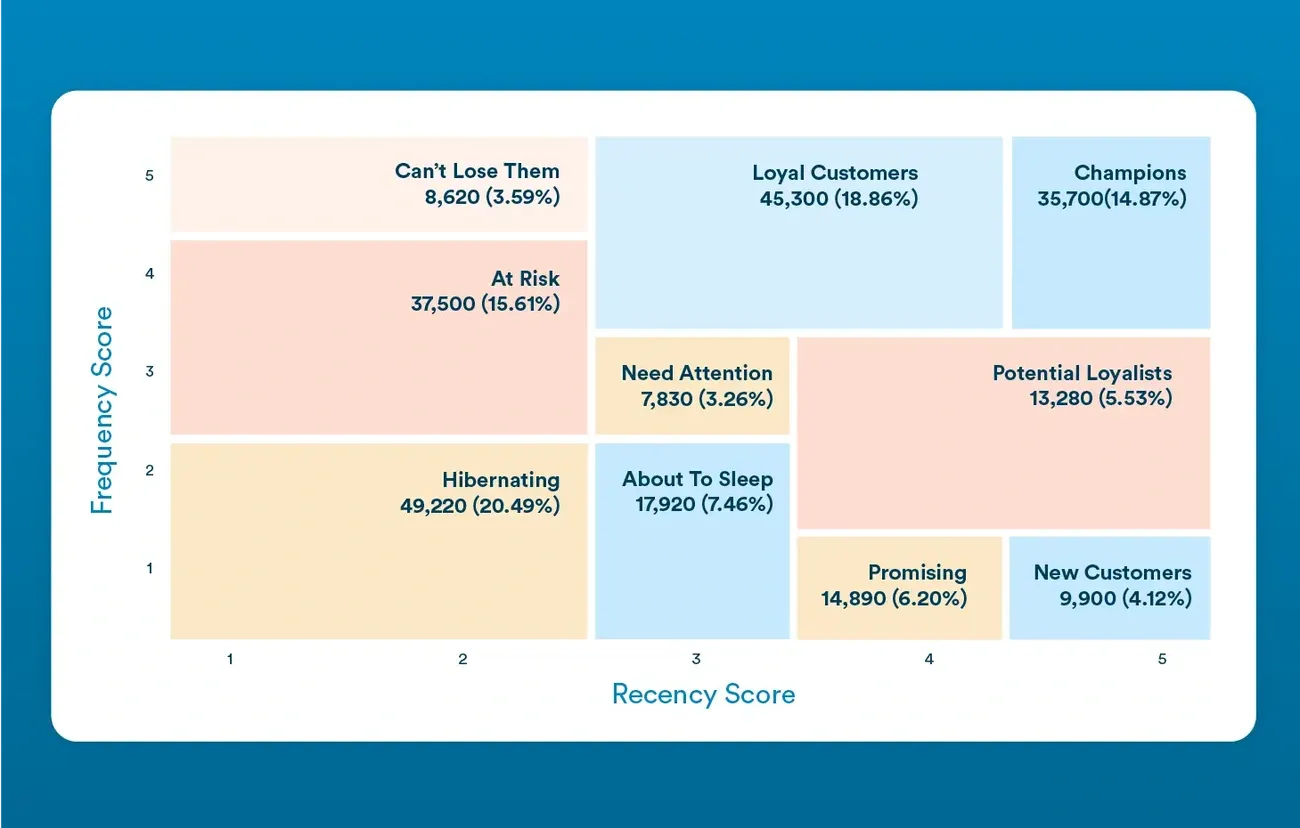
Image Source: CleverTap
Purchasing patterns show us what customers really value. RFM segmentation looks at customer behavior through three key dimensions that help predict what they’ll do next and who your best customers are.
What is RFM Segmentation
RFM segmentation looks at customers using three measurable factors:
- Recency: When did they last buy something
- Frequency: How often do they buy
- Monetary Value: How much do they spend
Direct mail marketers created this method that gives each customer a score from 1-5 in these categories, with higher numbers showing better results. A customer with a 5-5-5 score is your ideal customer – they bought something recently, shop often, and spend a lot.
Why RFM Segmentation works
Past buying patterns help predict what customers will do next. Companies that use RFM segmentation see real results:
- Campaign performance jumped 25% in just three months
- Customer spending went up 38% with tailored marketing
- Teams spotted at-risk customers before traditional metrics could
RFM analysis backs up the old saying that “80% of business comes from 20% of customers”. This helps companies focus their resources on customers who matter most.
How to apply RFM Segmentation
Here’s what you need to do to make RFM work:
- Gather transactional data with purchase dates, how often people buy, and what they spend
- Set up your scoring system based on your business size (1-5 for bigger customer bases, 1-3 for smaller ones)
- Score each customer in all three areas
- Group your customers into segments like Champions (high scores everywhere), At-Risk (haven’t bought recently), and Potential Loyalists (bought recently but not often)
- Create specific plans for each group with custom offers and messages
Note that you shouldn’t bombard your best customers with too many offers, while customers with lower scores might need more attention.
Satisfaction Score Segmentation
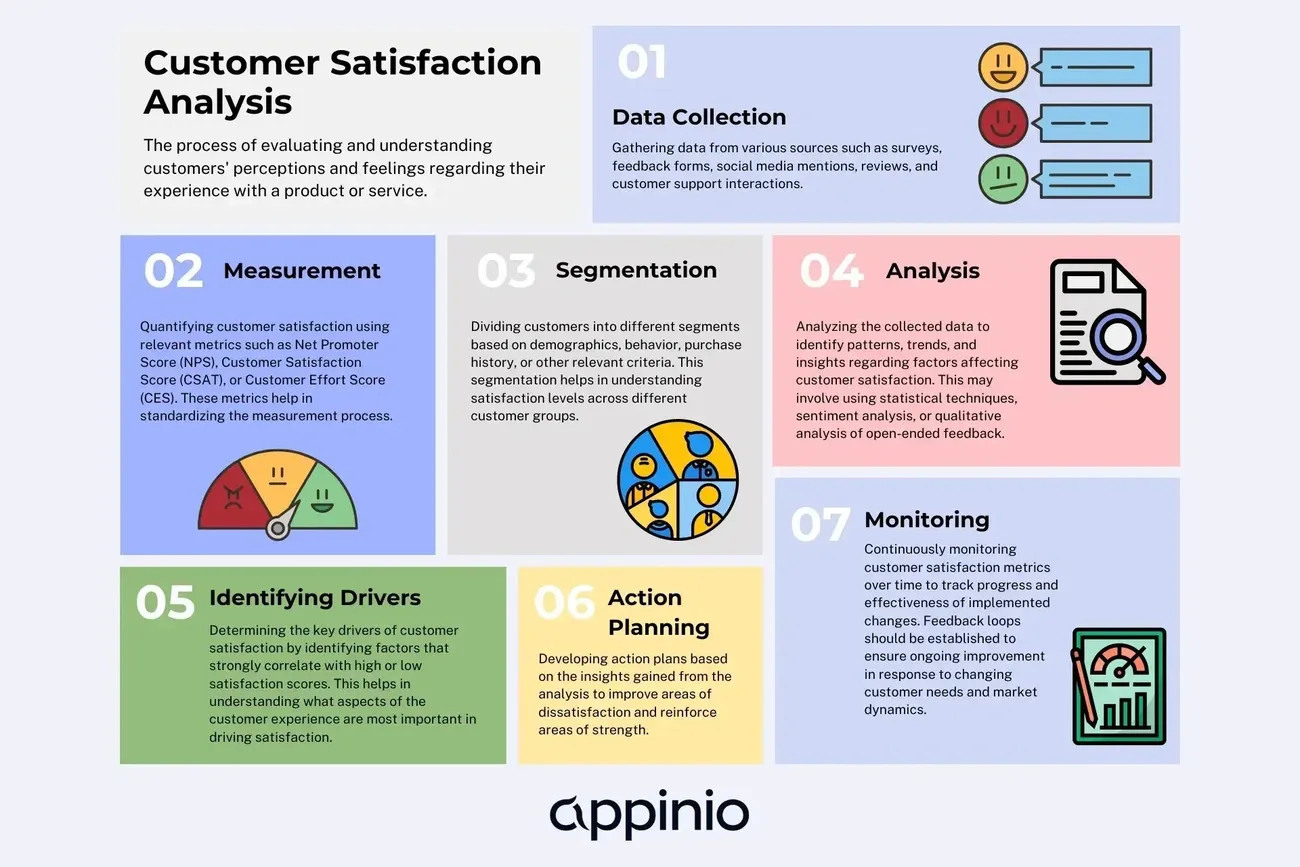
Image Source: Appinio
Customer feedback is the foundation of strategic business decisions. Satisfaction Score Segmentation splits your audience based on how they rate their experiences with your products or services. This reveals insights that demographic or behavioral data alone can’t capture.
What is Satisfaction Score Segmentation
Satisfaction Score Segmentation groups customers based on their reported satisfaction levels with your company’s offerings. This method uses metrics such as:
- Customer Satisfaction Score (CSAT)
- Net Promoter Score (NPS)
- Customer Effort Score (CES)
- Product satisfaction ratings
This approach does more than track overall happiness, it looks at satisfaction across specific customer segments to spot which groups are happy and which need help.
Why Satisfaction Score Segmentation works
Different customers value different aspects of your product or service. Some might be very satisfied despite being low-value bargain shoppers. Others might be quiet yet bring in major revenue through enterprise contracts.
Grouping customers by satisfaction levels helps businesses understand:
- Which high-value segments need immediate attention
- Where to put resources to get the best results
- If your happiest customers are also your most profitable ones
This method works because satisfied customers become loyal supporters who recommend your company to others, which directly affects growth and profitability.
How to apply Satisfaction Score Segmentation
Start by collecting satisfaction data through surveys, interviews, and feedback forms during the customer experience. Calculate metrics like CSAT (Number of Satisfied Customers ÷ Total Responses × 100) for each segment.
Once you have the data, look for satisfaction patterns within demographic, product category, or service-type segments. Create segment-specific strategies that address what drives satisfaction for each group. Premium customers might value white-glove service while price-sensitive segments want better deals.
The best approach is to match your customer experience investments to segments that drive revenue instead of trying to please everyone equally.
Channel-Based Segmentation
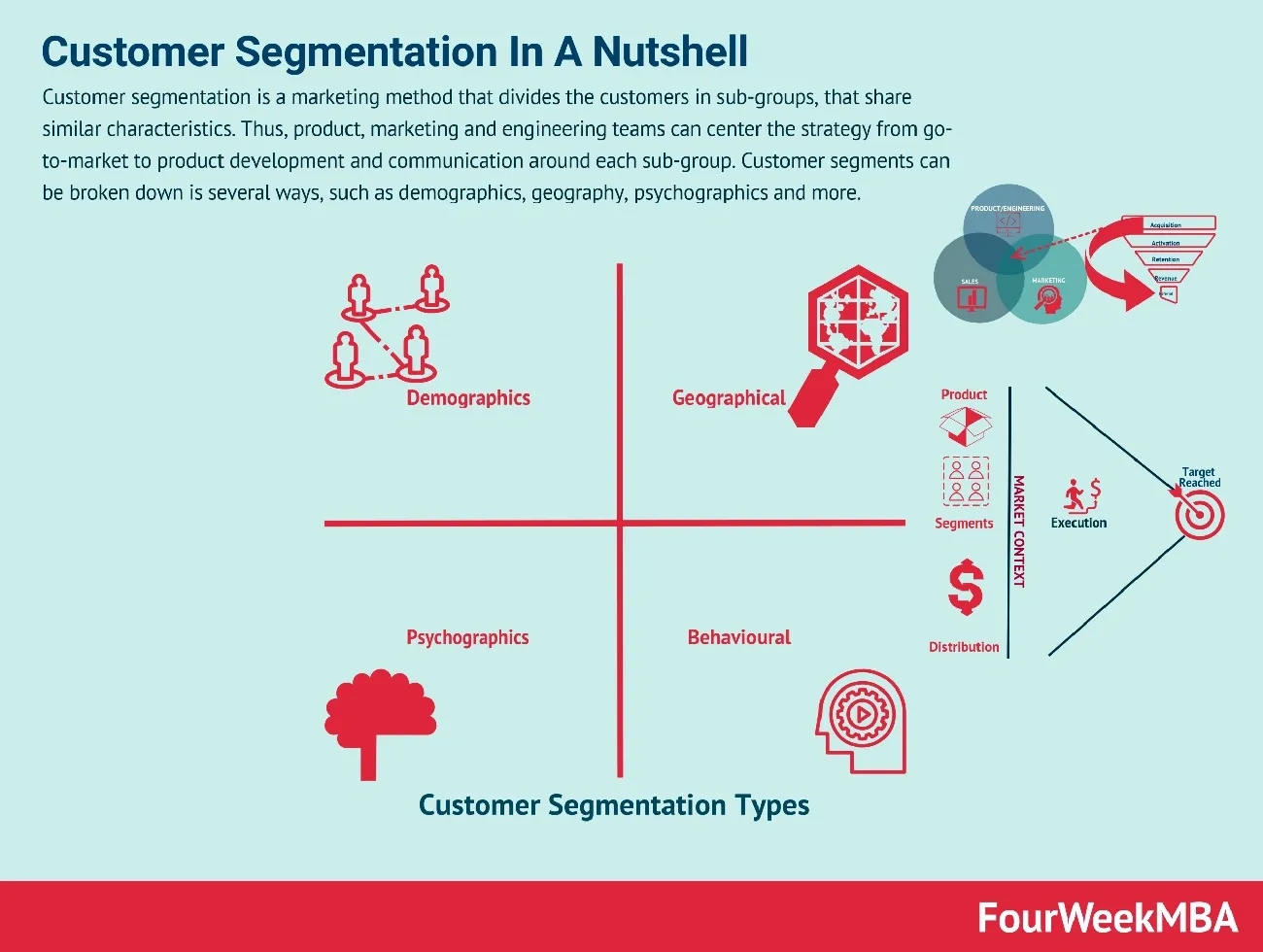
Image Source: FourWeekMBA
Customer priorities and communication choices drive their buying decisions and brand loyalty. Channel-based segmentation groups customers by how they want to interact with your brand. Different customers react uniquely to various marketing touchpoints.
What is Channel-Based Segmentation
Channel-based segmentation groups customers based on their most responsive communication channels. Here are the typical groups:
- Email-first shoppers who open promotional content regularly
- Social-first customers who respond well to Instagram or TikTok
- In-store driven customers who love physical retail experiences
- SMS responders who quickly act on text alerts
- Direct mail loyalists who respond best to catalogs or physical coupons
Customers mix digital and physical touchpoints throughout their brand experience. They don’t all use channels the same way.
Why Channel-Based Segmentation works
This segmentation approach delivers real results in several ways. We focused investments on channels with highest engagement. Brands report that their channel-segmented marketing gets better response rates by a lot compared to generic approaches.
Channel segmentation helps brands send targeted, relevant messages where customers want to connect. This method boosts satisfaction by respecting how customers want to receive communications throughout their lifecycle.
How to apply Channel-Based Segmentation
You need systematic data collection and analysis to implement this approach:
- Look at CRM data to find each customer’s top engagement touchpoints
- Ask about channel priorities during sign-up or after purchase
- Track UTM parameters and conversion sources to identify effective channels
- Combine channel data with other segments like demographics, location, and income to learn more
Test and refine your segment definitions as behaviors change. Modern marketing platforms let you assign customers to channel groups dynamically as their priorities evolve.
Device Type Segmentation
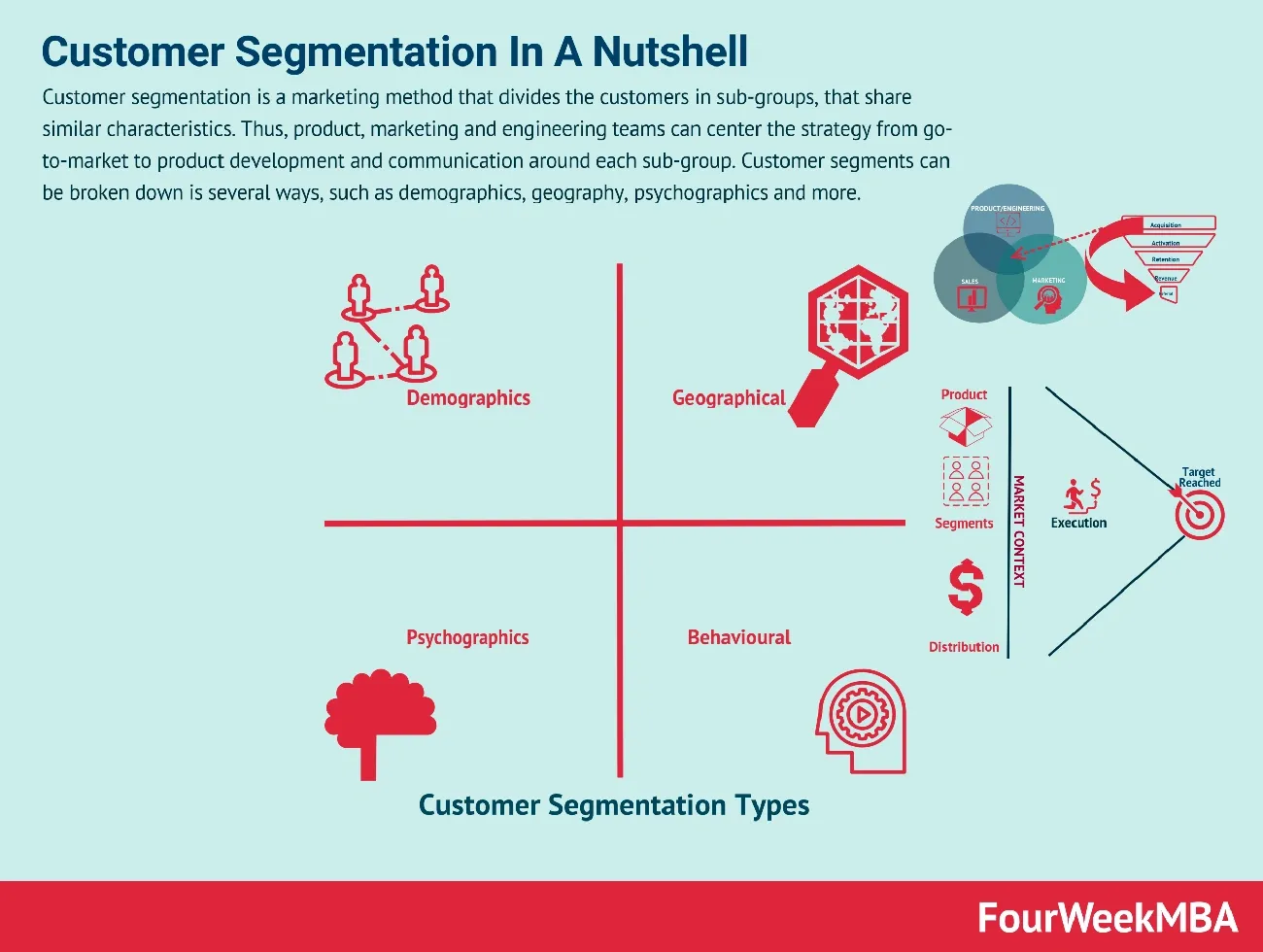
Image Source: FourWeekMBA
Customer behavior patterns emerge clearly through the screens they use to interact with brands. Your audience segments naturally based on their preferred technology for accessing products or services.
What is Device Type Segmentation
Device type segmentation groups users by their hardware choices when they engage with your brand. The main categories are:
- Smartphones and mobile devices (used by 96% of global internet users)
- Tablets (more popular among Baby Boomers than Millennials: 57% vs. 35%)
- Desktop/laptop computers
- Smart TVs and gaming consoles
This method gets into not just device categories but also specific models, operating systems, and software usage patterns.
Why Device Type Segmentation works
Knowledge of users’ device priorities helps create optimal experiences across platforms. We noticed that different contexts drive device usage, 82% of work-related browsing happens on desktops, while mobile devices serve on-the-go users.
Device choices relate to demographic and behavioral patterns. To cite an instance, Gen Z shows an overwhelming preference for smartphones with 98% ownership. Mobile optimization becomes vital for connecting with younger audiences.
How to apply Device Type Segmentation
Start by gathering device data through web analytics, mobile analytics, and customer feedback. The next step involves creating segments based on device types in your analytics platform. The final phase focuses on experience optimization for each segment, factoring in screen size, input methods, and usage patterns in different contexts.
Source-Based Segmentation
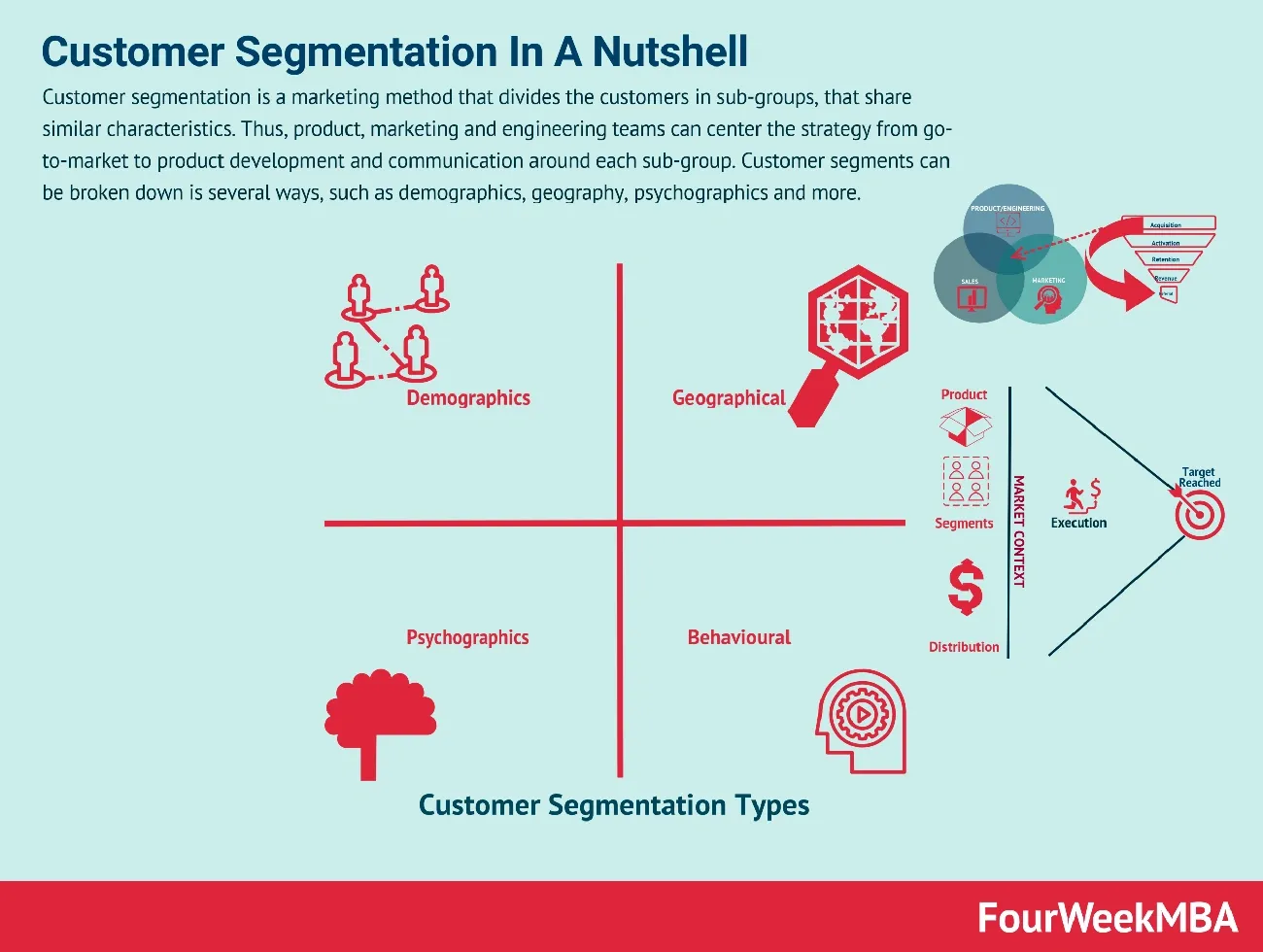
Image Source: FourWeekMBA
Marketing channels show vital patterns that drive customer acquisition and engagement. Source-based segmentation groups your audience based on how they found and connected with your brand. This method gives a clear explanation of channel effectiveness and customer priorities.
What is Source-Based Segmentation
Source-based segmentation groups customers by the marketing channel that brought them to your business. The sources typically include social media platforms (Facebook, Instagram), search engines (Google), email campaigns, referral programs, and traditional advertising. This detailed method helps companies find which specific touchpoints appeal most to different customer groups.
Why Source-Based Segmentation works
Source segmentation makes precise audience targeting possible while optimizing marketing spend. The data might show that 40% of your visitors arrive through Instagram Ads and only 5% find your brand on Facebook, though ad costs remain similar on both platforms. These numbers help determine where your target audience naturally gathers, which leads to smarter resource allocation.
How to apply Source-Based Segmentation
Source-based segmentation works best when you:
- Track visitor origins using UTM parameters and analytics tools
- Analyze channel performance metrics (traffic, conversion rates, customer value)
- Compare acquisition costs against customer lifetime value for each channel
- Reallocate marketing resources toward highest-performing channels
- Customize messaging to match your audience’s expectations on each platform
This method helps you reach potential customers where they spend their time naturally.
Coupon Usage Segmentation
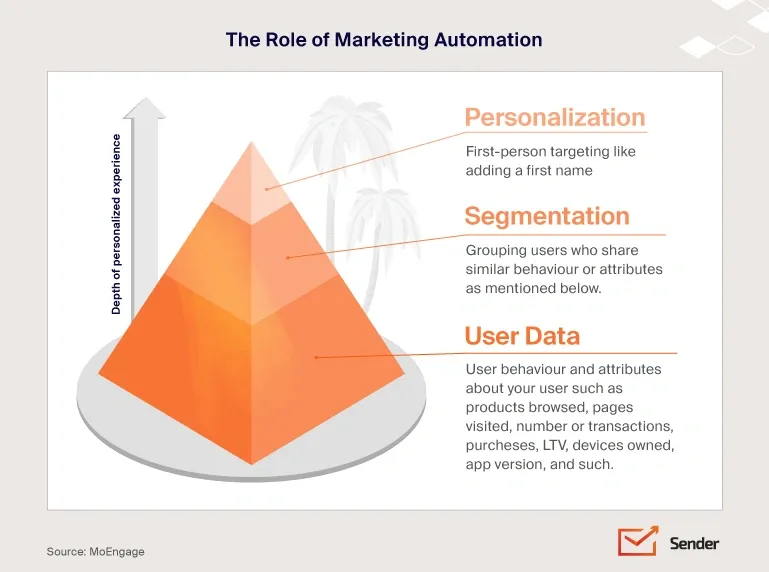
Image Source: Sender.net
Your marketing toolkit wouldn’t be complete without coupons – they’re excellent behavioral indicators. The way customers use coupons tells a unique story about their buying habits. This segmentation approach spots patterns that other methods might miss.
What is Coupon Usage Segmentation
The way customers redeem offers and respond to promotions creates natural groupings. Your tracking should include revenue from coupon orders, applied discounts, after-coupon revenue, discount percentages, and average order values. Different promotions create distinct buying patterns, and specific coupon types can trigger various customer behaviors.
Why Coupon Usage Segmentation works
We noticed clear differences between deal-hunters and customers who buy at full price. Smart coupon targeting leads to better engagement and brings in more customers. Research shows that well-planned coupon campaigns boost CLV (Customer Lifetime Value) and cut marketing expenses. The best part? Your customer’s coupon habits provide informed insights to guide marketing decisions.
How to apply Coupon Usage Segmentation
Start by gathering detailed redemption data and track orders before and after discounts. Look for patterns in how different coupon types perform. Some promotions work better to attract new customers while others keep existing ones coming back. You might want to group customers based on their response to different discount types – percentages off, fixed amounts, or minimum purchase deals. Each segment needs its own strategy.
Interest-Based Segmentation
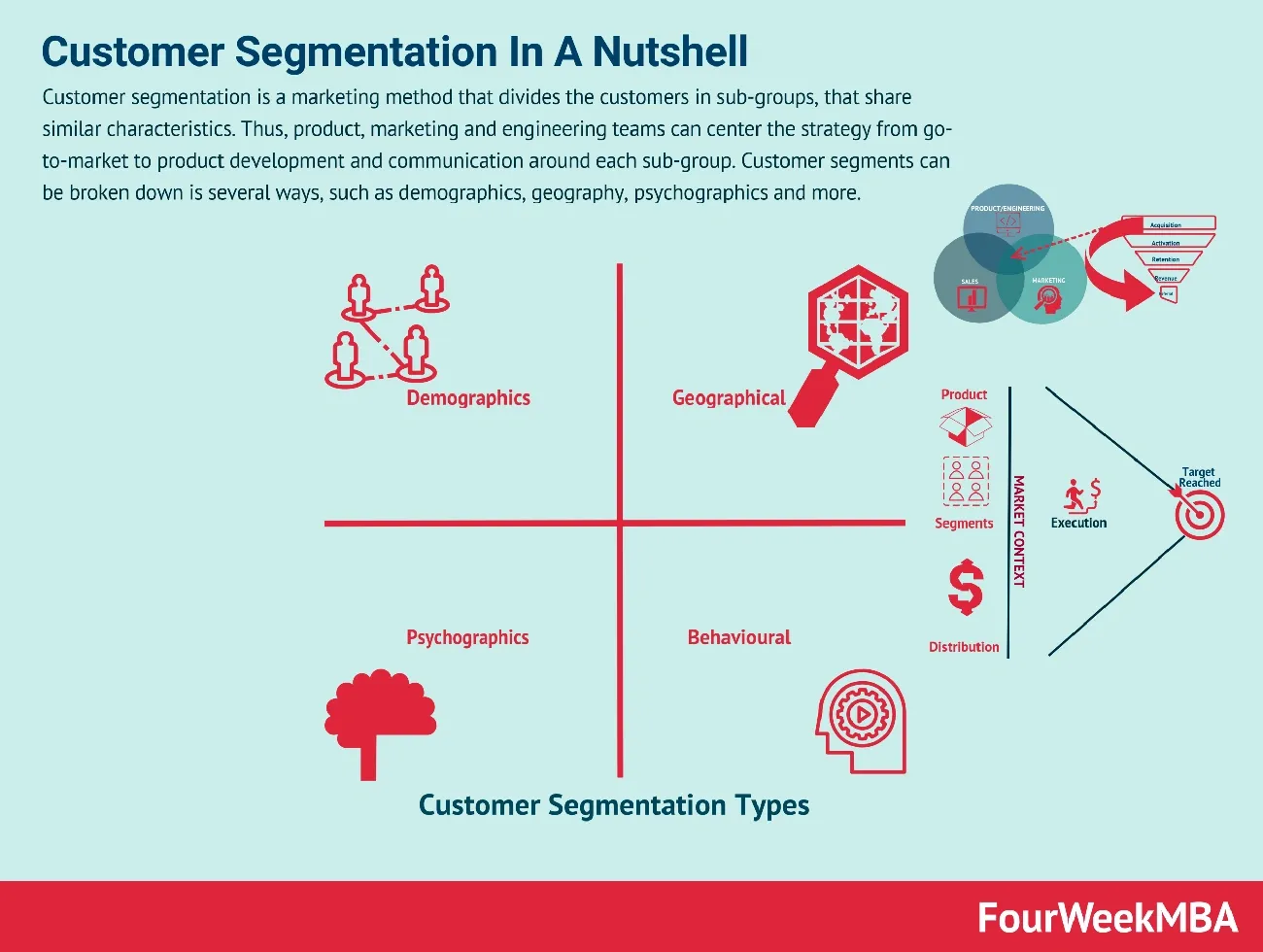
Image Source: FourWeekMBA
A customer’s personal interests and hobbies reveal important details about their priorities. Interest-based segmentation creates audience groups based on what people truly care about, which builds deeper connections than traditional demographic approaches.
What is Interest-Based Segmentation
This segmentation method splits customers into groups based on their stated or implied priorities, such as content they engage with, products they look at, or communities they join. A fitness app could group its users into yoga lovers, high-intensity interval trainers, and newcomers to fitness.
Common interest segments include:
- Sports enthusiasts who love specific equipment or apparel
- Travelers looking for luggage, accessories, or experiences
- Food lovers whose attention is drawn to gourmet products or dining experiences
Why Interest-Based Segmentation works
Businesses can deliver highly relevant messages that match their users’ passion points through interest segmentation. This tailored approach makes customers feel understood and valued by the brand. The method also helps companies find audiences in their natural gathering places, which optimizes resource use.
How to apply Interest-Based Segmentation
The process begins with data collection through surveys, social media monitoring, and browsing patterns. Marketing teams should use web analytics tools and CRM systems to learn about their audience’s priorities. Each segment needs customized content from targeted emails to product recommendations that match specific interests.
Comparison Table
Segmentation Method | Primary Variables/Metrics | Key Benefits | Implementation Approach |
Demographic | Age, gender, income, education, family status, ethnicity | – Marketing costs drop 50% while revenue grows 10-15% | – Surveys and forms collect data |
Behavioral | Purchase patterns, product usage, brand interactions, decision-making processes | – Conversion rates triple | – Purchase history and website behavior tracking |
Geographic | Location, climate, cultural priorities, time zones, population density | – Social media involvement grows 6x | – Location data gathering |
Psychographic | Values, lifestyle, personality traits, interests, social class | – Insights last longer than behavioral data | – Open-ended question surveys |
Technographic | Device ownership, software usage, cloud services, digital media consumption | – New target markets surface | – Web surveys |
Needs-Based | Customer problems, priorities, preferences | – Individual-specific experiences increase | – Surveys and feedback data collection |
Value-Based | Business value, involvement value, cost to service/acquire | – Customer lifetime value grows | – Transaction data collection |
Firmographic | Industry type, company size, revenue, structure | – Revenue grows 20% | – Clear objective setting |
Customer Trip | Touchpoint sequence, timing, emotional responses | – Segment-specific pain points surface | – Experience data collection |
Lifecycle Stage | Relationship phase, involvement level | – Email open rates reach 14.31% | – Involvement data tracking |
RFM | Recency, frequency, monetary value | – Campaign performance rises 25% | – Transaction data gathering |
Satisfaction Score | CSAT, NPS, CES, product ratings | – High-value segments needing attention emerge | – Satisfaction data collection |
Channel-Based | Preferred communication channels, involvement patterns | – Response rates climb | – CRM data analysis |
Device Type | Hardware priorities, operating systems | – User experiences optimize | – Device data collection |
Source-Based | Marketing channels, acquisition touchpoints | – Marketing spend optimizes | – Visitor origin tracking |
Coupon Usage | Redemption patterns, discount priorities | – Involvement rates rise | – Redemption data tracking |
Interest-Based | Content priorities, browsing patterns, community involvement | – Messages become hyper-relevant | – Priority data collection |
Conclusion
Customer segmentation analysis remains a key strategy that helps businesses maximize their marketing effectiveness. This piece explores 17 different segmentation methods that market leaders use to get results. Of course, these approaches know how to turn generic marketing into customized experiences that strike a chord with specific audience groups.
Picking the right segmentation methods needs a careful look at your data, goals, and your target audience’s traits. Research shows that companies using proper segmentation see major improvements in many areas – from better conversion rates to stronger customer loyalty and higher lifetime value.
On top of that, it works best to combine multiple segmentation approaches to understand your customer base completely. To name just one example, see how matching demographic data with behavioral insights creates a richer picture of your audience than demographics alone.
Data analytics and artificial intelligence make the segmentation landscape change faster. Notwithstanding that, one basic principle stays the same: customers want customized experiences that match their unique needs and priorities.
Now that you know these segmentation methods, you should evaluate which approaches line up with your business needs. Start by checking your current data collection abilities and spot any gaps you need to fix. Then pick the segmentation methods that fit your industry and audience best. Last, put these strategies in place step by step, track results and fine-tune your approach as you go.
Customer segmentation analysis works as more than just a marketing tool, it’s a complete business strategy that puts customers first in every decision. Companies that become skilled at these segmentation techniques will without doubt gain major competitive edges in the increasingly customized marketplace of 2025 and beyond.
Key Takeaways
Customer segmentation analysis transforms generic marketing into targeted experiences that drive measurable business results across 17 proven methods.
• Segmentation delivers significant ROI: Companies using proper segmentation report 50% reduced marketing costs while increasing revenue by 10-15%, with personalization yielding $20 for every $1 invested.
• Behavioral data outperforms demographics: Behavioral segmentation achieves 3x higher conversion rates and 14.31% higher email open rates by focusing on what customers actually do rather than who they are.
• Combine multiple methods for best results: The most effective approach pairs different segmentation types, like demographic with behavioral insights to create comprehensive customer understanding that single methods cannot provide.
• RFM analysis predicts future behavior: Recency, Frequency, and Monetary segmentation improves campaign performance by 25% and increases customer spending by 38% within three months of implementation.
• Value-based segmentation maximizes profitability: Prioritizing customers by their economic contribution helps allocate resources efficiently, with companies reporting up to 20% higher revenue growth through sophisticated segmentation strategies.
The key to successful segmentation lies in selecting methods that align with your data capabilities and business goals, then implementing them systematically while continuously measuring and refining your approach for optimal results.
FAQs
Q1. What are the most effective customer segmentation methods? The most effective customer segmentation methods include demographic, behavioral, geographic, psychographic, and firmographic segmentation. Each approach offers unique insights into customer characteristics and behaviors, allowing businesses to tailor their marketing strategies more precisely.
Q2. How does behavioral segmentation differ from demographic segmentation? Behavioral segmentation focuses on customer actions and interactions with a brand, such as purchasing patterns and product usage. Demographic segmentation, on the other hand, categorizes customers based on observable characteristics like age, gender, and income. Behavioral segmentation often provides more actionable insights for personalized marketing.
Q3. What is RFM analysis and why is it important? RFM (Recency, Frequency, Monetary) analysis is a customer segmentation method that evaluates customers based on their recent purchase history, how often they buy, and how much they spend. It’s important because it helps identify high-value customers and predict future behavior, allowing businesses to tailor their marketing efforts more effectively.
Q4. How can AI enhance customer segmentation strategies? AI can enhance customer segmentation by analyzing vast amounts of data to identify patterns and predict customer behavior. It enables more dynamic and real-time segmentation, allowing businesses to deliver highly personalized experiences and content. AI can also help in creating more accurate customer journey maps and optimizing marketing campaigns.
Q5. What are the benefits of implementing multiple segmentation methods? Implementing multiple segmentation methods provides a more comprehensive understanding of customers. It allows businesses to create multidimensional customer profiles, combining insights from different approaches such as demographic, behavioral, and psychographic segmentation. This holistic view enables more targeted marketing strategies, improved customer experiences, and ultimately, better business outcomes.
“If you found this guide useful, join my free Business Intelligence Edge newsletter for weekly, practical data-driven insights to grow your business.”
Read more Blog Post


